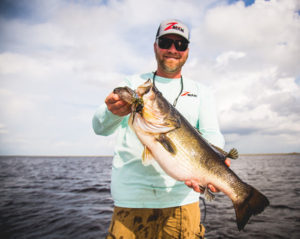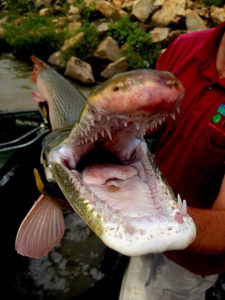Unmasking the Unnamed Bladed Jig
from The Fishing Wire

Bladed jigs catch big bass for Luke Clausen
In bass circles, it’s become a something of running wise-crack. You might think of it along the lines of that secret spot your buddies call Lake X—so hot for big fish you simply can’t let the cat out of the bag. Except, this one’s a lure, not a lake.
Conspicuous by the absence of an actual brand name, something called an unnamed bladed jig has recently racked up mega bucks on the FLW, BASS and Major League Fishing tours. In a pastime rife with pseudo-hype and over-exaggerations, this one stands apart as the real deal—a lure that’s lived up to the propaganda, even exceeded it.
Consider the following intel from recent tournament coverage:
Referring to the bait cast by the 2019 Bassmaster Classic champion, tournament coverage included the following excerpt: “A key lure on Championship Sunday was a 3/8-ounce unnamed bladed jig, chartreuse white, with an unnamed pearl white, fluke-style trailer.”
In the days following the Classic, press and fan commentary had all arrived at the same conclusion: the unnamed bladed jig was a Z-Man ChatterBait JackHammer. One article focused specifically on the “mystery lure” and the far-from-uncommon phenomenon of anglers glossing over certain successful, non-sponsor lures, while on stage.
In tournament circles, the Z-Man ChatterBait JackHammer has become known as the “unnamed bladed jig.”
At the 2018 Classic, a rare candid moment unfolded when Gerald Swindle announced: “I caught every bass this week on a half-ounce ChatterBait, the JackHammer. I’m not sponsored by ‘em; I paid fifteen-ninety-nine a piece for ‘em, just like y’all do. I got about eleven-hundred dollar’s worth of them; I won’t lie to you.” Swindle wasn’t alone, as numerous other Classic contenders wielded what had become the hottest unidentified bait in bass fishing circles.
And in February 2019, Stage One winner of the MLF Bass Pro Tour at Lake Kissimmee, FL used an unnamed “bladed jig.” Once again, fans and fishing pundits speculated the lure to be a ChatterBait JackHammer.
“A Different Way to Make a Lure Wiggle”
It all started when Ron Davis, a creative lure designer from Rock Hill, South Carolina, added high-level action and vibration to a larger-profile, weighted jig. Davis drew his inspiration from the Walker Special, a vibrating lure resembling the pull-top on an old aluminum can, circa 1960. His original, admirable intent was to create “a different way to make a lure wiggle.”
Finally, in 1998, Davis engineered a unique way to attach a hex-shaped blade directly to a jig. Things began to click. Davis and his son Ron Davis Jr. sold 5,000 of their new “ChatterBaits” under the Rad Lures brand. After winning tournaments in 2005 and 2006, Bryan Thrift divulged his secret, chosen baits for the first time. ChatterBait sales skyrocketed to 25,000 lures, and when orders eclipsed six figures and projections exceeded 2 million, the Davises decided to sell its designs to Z-Man Fishing in 2008.
Perhaps it was inevitable that ChatterBait reproductions arrived, slowly at first, then en masse, as numerous tackle companies attempted to cash in on the success of a truly original and stunningly effective design.
Major League Fishing pro Luke Clausen details subtle differences between bladed bass jigs.
The Critical Connection
Recognizing the lure’s exceptional engineering early on, Davis successfully attained patent protection for his ChatterBait—a patent that has been preserved by Z-Man Fishing to this day. The key to the lure’s action, vibration, sound and ultimately, its efficacy, points directly to the blade-to-jig connection. According to the Davises, the lure’s driving force remains a thin, hex-shaped, bent blade, attached to a weighted hook in such a way as to restrict the blade’s oscillation.
“I’ve been throwing ChatterBaits since 2004,” says Thrift, a talented touring pro with ten FLW tournament wins and over $2.5-million in career earnings. “When I won at Okeechobee in 2006, the fish had never seen (the ChatterBait) before; it was just unimaginable the big fish I caught with the bait down there.”
Thrift and others believe the key to the ChatterBait’s big bass allure points directly to Davis’ design. “The direct connection between the blade and the jig restricts the blade’s movement and provides a side-to-side stopping point,” notes Thrift.
“I think most anglers know, by now, that if you put a split ring between the blade and the hook, it’s going to change the action dramatically, and drastically reduce the bait’s vibration,” believes Daniel Nussbaum, president of Z-Man Fishing. “In essence, a lure with a split ring isn’t a ChatterBait.
“A ChatterBait simply generates a totally different sound and vibration that you feel up and down the rod,” says Thrift. “Bass respond to it like no other vibrating bait you’ll fish.
“The other key thing that happens is the sound the lure makes as the blade repeatedly collides with the head. After a while, you get a unique paint wear pattern and the sound changes to a lower frequency, duller thud. Each ChatterBait version, from the original to the Project Z to the JackHammer all give off slightly different action and frequency vibration.”
The JackHammer, for example, is built with a flat-bottom, low-center-of-gravity head with a specialized channel groove for blade protection. “The JackHammer and the Project Z ChatterBait are both super-tuned lures that start vibrating and pulsing with the very first turn of the reel handle,” says Thrift.
The direct blade-to-jig connection is key to the success of the ChatterBait bladed jig.
Project Z
Interestingly, while the JackHammer continues to garner “unnamed” headlines and tournament wins, both Thrift and Major League Fishing Tour angler Luke Clausen rely on an alternative Z-Man bait, the Project Z.
“People see the price tags of the two lures and think the JackHammer must be better, which isn’t necessarily the case,” believes Thrift.
“The Project Z is maybe the first perfect ChatterBait ever made,” he asserts. “It’s got a high-level Mustad UltraPoint hook, and an awesome skirt and keeper. Also allows me to quickly and easily change the skirt if I need to. I can even mix and match blade colors so I can fish white/chartreuse with a gold blade in dirty water or green pumpkin with a gold blade in other conditions.
“What separates the lure from other ChatterBaits is that I can slow roll it past cover and then burn it back. It moves with a darting, hunting action, back-and-forth. I also use it a lot on offshore structure or ledges. Let it go to bottom and then rip it with the rod and let it flutter back. I’ve caught lots of bass on the Project Z bait down to 25 feet of water.”
Meanwhile, Clausen prefers the larger profile of the Project Z ChatterBait, and the fact he can fish it faster, burning it across shallow cover. “In clear or cold water, I’ll sometimes remove the skirt and replace it with a Jerk ShadZ for a realistic baitfish profile.
“The blade swings wide and wobbles a little more slowly, producing a nice deep, low frequency vibration. The blade doesn’t contact the jighead, but doesn’t have to, because the lure thumps so much. The Project Z bait is sort of a hidden gem among Z-Man’s ChatterBait line. It’s my favorite ChatterBait, hands-down— versatile enough to mimic a bluegill, shad or a crayfish.”
Big bass magic. Money winner. Unnamed bladed jig. Whatever you choose to call it, there can be but one original ChatterBait.
Bladed jig master Bryan Thrift believes the Project Z ChatterBait is the most underrated lure in the category.

